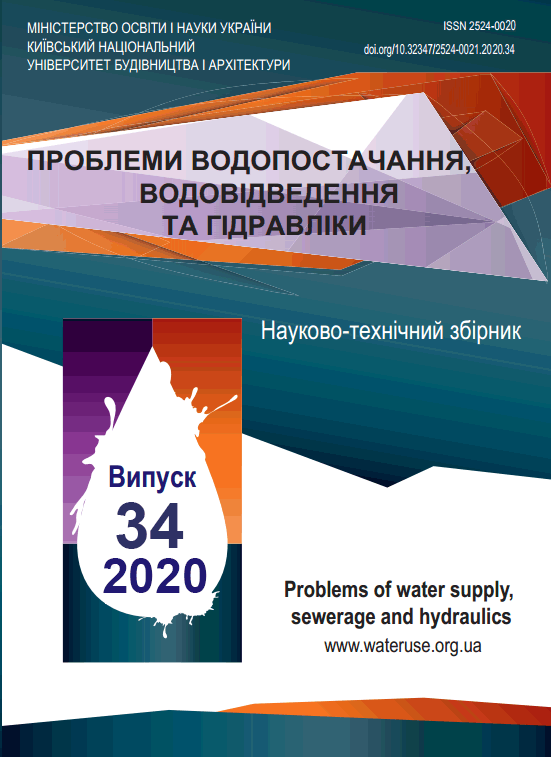Theoretical fundamentals of mathematical modeling of the process of wastewater treatment of galvanic productions
DOI:
https://doi.org/10.32347/2524-0021.2020.34.4-11Ключові слова:
heavy metal ions, pollution, environment, galvanic production, wastewaterАнотація
Among the problems of environmental protection an important place is occupied by the decision of the questions directed on minimization of natural objects pollution. Pollution by hazardous chemicals of the environment (surface water bodies, atmospheric air, soil) has a negative impact on the state of the biosphere and on the population health. Intensive development of industry, agriculture, infrastructure and other industries directly affect the environment. Electroplating is a common component in many industries. In turn, emissions from galvanic production lead to environmental and economic losses. One of the issues that still needs to be addressed is the disposal of waste from such industries. Heavy metals enter the reservoirs with runoff of insufficiently treated wastewater and surface runoff from enterprises that use galvanic coating of metal surfaces or where dyes are used. Such a method of wastewater treatment from heavy metal ions as galvanocoagulation is widely used in the treatment of wash water, which is a waste from the process of electroplating. In this article, a mathematical model of the process of wastewater treatment from heavy metal ions by electroplating was developed and proposed on the basis of research and analysis of existing wastewater treatment processes from heavy metal ions. As a result of solving this mathematical problem, formulas were obtained for calculating the working height of the filter with a sufficient number of magnesium ions. Conclusions are also given on ways to reduce the negative impact of galvanic production on the components of the environment. Thanks to the use of a systematic approach, organizational and technical solutions, effective wastewater treatment will be ensured from pollution and the amount of production waste will be reduced.Посилання
Vinogradov, S. S. (2002). Environmentally friendly electroplating. Moscow: Globus. [in Russian]
Ilyin, V. I., Gubin, A. F., & Kolesnikov, V. A. (2011). Minimization of the for-mation of hazardous chemical liquid waste in electroplating (review). Defense complex – to the scientific and technical progress of Russia, 1, 29-42. [in Russian]
Danilov-Danilyan, V. I. (2008). Global problem of shortage of fresh water. Age of Globalization, 1, 45-56.[in Russian]
Danilov-Danilyan, V. I. (2006). Water consumption: Environmental, economic, social and political aspects. Moscow: Nauka. [in Russian]
Kafarov, V. V. (1975). Basics of Mass Transfer. Moscow: Higher school [in Russian]
Romanenko, N. G., & Kurykina, M. I. (1982). Hydromechanical processes of chemical technology. Leningrad: Chemistry. [in Russian]
Oliynyk, O. Ya., & Kiselyov, S. K. (2003). Theoretical research of pressure losses on purification filters during water deironing. Problems of water supply, sewerage and hydraulic, 1, 3-12.[in Ukrainian]
Ternovtsev, V. O., & Vasylenko L. O. (2003). Theoretical bases of water purification from heavy metal ions by galvanocoagulation. Problems of water supply, sewerage and hydraulic, 1, 80-85. [in Ukrainian]
Kiselev S. K. (2004). Modeling and calculations of deironing of water on purification filters taking into account changes of hydraulic properties of loading (Candidate’s thesis). Kyiv National University of Construction and Architecture, Kyiv. [in Russian]
Tatura, H., Goto, K., & Nagayama, M. (1976). The effect of ferric hydroxide on the oxygenation of ferrous ions in neutral solutions. Corrosion Science, 16(4), 197-207. doi:10.1016/0010-938x(76)90046-9
Sung, W., & Morgan, J. J. (1980). Kinetics and product of ferrous iron oxygenation in aqueous system. Environmental Science & Technology, 14(5), 561-568. doi: 10.1021/es60165a006
Jobin, R., & Chosh, M. M. (1972). Effect of buffer intensity and organic matter on oxygenation of ferrous iron. Journal – American Water Works Association. 64(9), 590-595. doi:10.1002/j.1551-8833.1972.tb02752.x
Hackett, J. (1987). A review of chemical treatment strategies for iron bacteria in wells. Water. Well J., February, 37-42.
Smith, S. (1980). A Lauman’s guide to iron bacteria problems in wells. Water. Well J., June, 40-42.
Smith, S. (1982). Culture methods for the anumeration of iron bacteria from water well somples – a critical literature review. Ground Wat., 20(4), 482-485.
Tuhela, L., Carlson, L., & Tuovinen, O. H. (1997). Biogeochemikal transformations of Fe and Mn in oxic groundwater and well water environments. J. of Envir. Science and Health. Part A: Envir. Science and Engineering. and Toxicology, 32(2), 407-426. doi: 10.1080/10934529709376551
Koenig, L. (1960). Survey and analysis of Well Stimulation Performance. Journal – American Water Works Association, 52(3), 333-350. doi:10.1002/j.1551-8833.1960.tb00497.x
Woolschlager, J, & Rittmann, B. E., (2005). Que mesurent les tests de CODB et de COA? Revue des sciences de l'eau, 8(3), 371-385. doi:10.7202/705229ar
Stumm, W., & Lee, G.F. (1960). The chemistry of aqueous iron. Schweizerische Zeitschriftfür Hydrologie, 22(1), 295-319. doi: 10.1007/bf02503278
Rebhun, M. (1984). Contact flocculation-filtration of humic substances. Water Res., 18(8), 963-970. doi:10.1016/0043-1354(84)90246-x
McGhee, T. J. (1991). Water supply and sewerage. New York: McGraw-Hill.
Schenk, J. E., & Weber, W. J. (1968). Chemical Interactions of Dissolved Silica with Iron (II) and (III). Journal – American Water Works Association, 60(2), 199-212. doi:10.1002/j.1551-8833.1968.tb03534.x
##submission.downloads##
Опубліковано
Як цитувати
Номер
Розділ
Ліцензія
Автори, які публікуються у цьому журналі, погоджуються з наступними умовами:
a) Автори залишають за собою право на авторство своєї роботи та передають журналу право першої публікації цієї роботи, яка через 70 років після смерті останнього співавтора з дати публікації автоматично стає доступною на умовах ліцензії Creative Commons Attribution License, котра дозволяє іншим особам вільно розповсюджувати опубліковану роботу з обов'язковим посиланням на авторів оригінальної роботи та першу публікацію роботи у цьому журналі.
b) Автори мають право укладати самостійні додаткові угоди щодо неексклюзивного розповсюдження роботи у тому вигляді, в якому вона була опублікована цим журналом (наприклад, розміщувати роботу в електронному сховищі установи або публікувати у складі монографії), за умови збереження посилання на першу публікацію роботи у цьому журналі.
c) Політика журналу дозволяє і заохочує розміщення авторами в мережі Інтернет (наприклад, у сховищах установ або на особистих веб-сайтах) рукопису роботи, як до подання цього рукопису до редакції, так і під час його редакційного опрацювання, оскільки це сприяє виникненню продуктивної наукової дискусії та позитивно позначається на оперативності та динаміці цитування опублікованої роботи (див. The Effect of Open Access).


